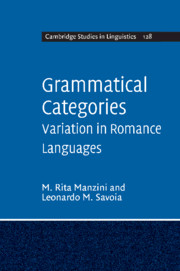Book contents
- Frontmatter
- Contents
- List of tables
- Acknowledgements
- Introduction: grammatical categories and the biolinguistic perspective
- 1 The structure and interpretation of (Romance) complementizers
- 2 Variation in Romance k-complementizer systems
- 3 Sentential negation: adverbs
- 4 Sentential negation: clitics
- 5 The middle-passive voice: evidence from Albanian
- 6 The auxiliary: have/be alternations in the perfect
- 7 The noun (phrase): agreement, case and definiteness in an Albanian variety
- 8 (Definite) denotation and case in Romance: history and variation
- Notes
- References
- Index
1 - The structure and interpretation of (Romance) complementizers
Published online by Cambridge University Press: 11 April 2011
- Frontmatter
- Contents
- List of tables
- Acknowledgements
- Introduction: grammatical categories and the biolinguistic perspective
- 1 The structure and interpretation of (Romance) complementizers
- 2 Variation in Romance k-complementizer systems
- 3 Sentential negation: adverbs
- 4 Sentential negation: clitics
- 5 The middle-passive voice: evidence from Albanian
- 6 The auxiliary: have/be alternations in the perfect
- 7 The noun (phrase): agreement, case and definiteness in an Albanian variety
- 8 (Definite) denotation and case in Romance: history and variation
- Notes
- References
- Index
Summary
In this chapter we start from the observation that in Romance languages, complementizers are nominal, belonging to the same argumental series as wh–phrases, although current theories treat them as functional projections of verbs, filling the same positions as verbs do. We argue that the Romance che-type complementizer is not a functional category of the verb, but rather a nominal head, which satisfies an argument slot of the matrix verb and which takes the embedded sentence as its complement (section 1.1). Both as a wh–phrase and as a complementizer, Italian che introduces a variable. If it introduces an individual variable, the wh–phrase reading arises; if it introduces a propositional variable (ranging over situations or possible worlds) it is read as a so-called complementizer.
In section 1.2, we argue that our proposal is compatible with fine distributional evidence relating to the left periphery of the sentence, in particular with the fact that elements such as topics or foci can occur both below the complementizer and above it. We capture this distribution by allowing them to occur at the left periphery of the embedded sentence (below the complementizer) or at the left periphery of the complementizer phrase (above the complementizer). This structural hypothesis predicts that occurrences of the relevant material below and above the complementizer can combine – a fact that requires quite complex functional hierarchies in alternative accounts.
Information
- Type
- Chapter
- Information
- Grammatical CategoriesVariation in Romance Languages, pp. 13 - 48Publisher: Cambridge University PressPrint publication year: 2011
